|
|
Cruthú Ádhamh - Creation of Adam
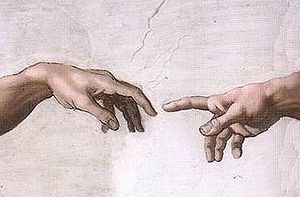
The Sistine Chapel ceiling, painted by Michelangelo for just over four years
between 1508 and 1512, at the
commission of Pope Julius II, are the most famous ceiling frescoes on the planet.
The ceiling is that of the large Papal Chapel built within the Vatican
between 1477 and 1480 by Pope Sixtus IV after whom it is named the Sistine Chapel. The
chapel is the location for Papal Conclaves and other important events.
The illustration above is that of God's finger reaching out to Adam's limp and lifeless hand at the moment of
creation. It is the iconic image of the Hand of God giving life to Adam.
It is on the chapel ceiling. The text below is from the bible recounting
the creation narrative from the book of Genesis.
 inne Dia an uile chineál tiarnas acu ar iasc na farraige, ar éanlaith
an aeir, ar an eallach, ar an talamh go léir, agus ar na péisteanna go
léir a shníonn ar an talamh.
inne Dia an uile chineál tiarnas acu ar iasc na farraige, ar éanlaith
an aeir, ar an eallach, ar an talamh go léir, agus ar na péisteanna go
léir a shníonn ar an talamh.
|
25. God made all kinds of wild animals, all kinds of cattle, and all kinds of creeping
things of the earth. God saw how good it was.
|
26. Dúirt Dia: Déanaimis an duine ar ár ndeilbh féin, ar
ár gcosúlacht féin, agus bíodh tiarnas acu ar iasc na
farraige, ar éanlaith an aeir, ar an eallach, ar an talamh go léir, agus ar
na péisteanna go léir a shníonn ar an talamh.
|
26. Then God said: "Let us make man in our own image, after our likeness. Let them have
dominion over the fish of the sea, the birds of the air, and the cattle, and over all the
wild animals and all the creatures that crawl on the ground."
|
27.Chruthaigh Dia an duine ar a dheilbh féin,
ar dheilbh Dé is ea a chruthaigh sé é.
Fireann agus baineann is ea a chruthaigh sé iad.
|
27. God created man in his image; in the divine image he created him; male and female he
created them.
|
|
28. Agus bheannaigh Dia iad á rá leo: “Bígí torthach, agus téigí i líonmhaire agus líonaigí
an talamh agus cuirigí smacht air. Bíodh tiarnas agaibh ar iasc na farraige, ar éanlaith an
aeir agus ar an uile dhúil bheo a chorraíonn ar talamh.
|
28. God blessed them, saying: Be fertile and multiply; fill the earth and subdue it. Have
dominion over the fish of the sea, the birds of the air, and all the living things that
move on the earth."
|
|
29. Dúirt Dia: Féach! Thugas daoibh gach uile lus le síol dá
bhfuil ar chlár na talún, agus gach uile chrann le síol ina
dtoradh; iadsan a bheidh ina mbia agaibh.
|
29. God also said: "See, I give you every sead-bearing plant all over the earth and every
tree that has seed-bearing fruit on it to be your food.
|
|
30. Mar bhia ag na hainmhithe allta go léir, ag
éanlaith an aeir go léir, agus ag na péisteanna go léir a
bhogann ar talamh tugaim glas gach fáis. Agus bhí sin amhlaidh.
|
30. and to all the animals of the land, all the birds of the air, and all the living
creatures that crawl on the ground, I give all the green plants for food." And so it
happened.
|
|
31. Chonaic Dia gach a ndearna sé agus, féach! bhí sé go
sármhaith. Ba shin an séú lá, an nóin agus an mhaidin.
|
31. God looked at everything he had made, and found it very good. Evening came, and
morning followed -- the sixth day.
|
The left below is the full image of Adam and God. To its right is a small display of the
ceiling of the Chapel. Below both is a much larger ceiling display.
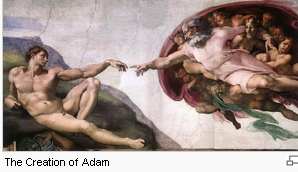 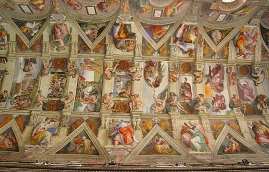
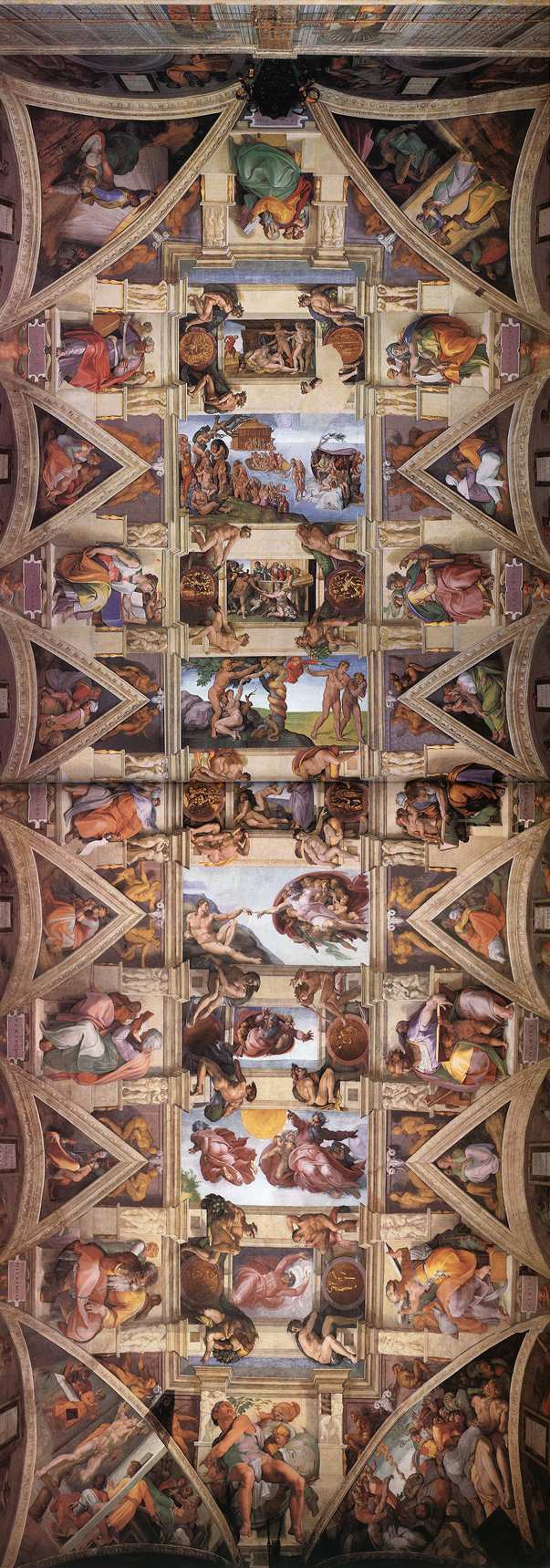
The overt subject matter of the ceiling is the doctrine of humanity's need for salvation
as offered by God through Jesus. It is a visual metaphor of humankind's need for a
covenant with God. The old covenant of the Children of Israel through Moses and the new
covenant through Christ had already been represented around the walls of the chapel.
The downfall of Adam and Eve and their expulsion from the Garden of Eden are on the ceiling.
The main components of the design are nine scenes from the book of Genesis, of which five
smaller ones are each framed and supported by four youths or Ignudi. At either end,
and beneath the scenes are the figures of twelve men and women who prophesied the birth of
Jesus.
The narrative elements of the ceiling illustrate that God made the World as a perfect
creation and put humanity into it, that humanity fell into disgrace and was punished by
death and by separation from God. Humanity then sank further into sin and disgrace, and
was punished by the Great Flood. Through a lineage of ancestors from Abraham to Joseph,
God sent the saviour of humanity, Christ Jesus.
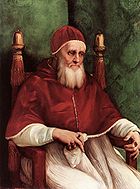 To the left is Pope Julius II who comissioned Michaelangelo to paint the Sistene Chapel.
Michelangelo took 4 years and longer and the pope became impatient. Upon leaving the altar
below after celebrating holy mass, he would say to the artist "Make an end, Michaelangelo,
make and end !"
To the left is Pope Julius II who comissioned Michaelangelo to paint the Sistene Chapel.
Michelangelo took 4 years and longer and the pope became impatient. Upon leaving the altar
below after celebrating holy mass, he would say to the artist "Make an end, Michaelangelo,
make and end !"
Since work would go on with the ceiling even during the celebration of mass on the altar
below in the chapel, Pope Julius and the cardinals would complain about the noise and the
dust coming down from above.
Often Julius did not pay the artist on time and Michaelangelo was found
begging for his wages. At one point the church was broke and could not buy
paint for the ceiling. The pope then bestowed a papal honor on the sons of a wealthy
family to raise the money.
Courtesy of Vivian and Jack, IrishPage.com Feb. 2010
Illustrations from Wikipedia encyclopedia.
English text from The New American Bible. ed 1972 pg. 2.
Irish text and translation from Biobla Naofa by an tAth. Donnchadh Ó Floinn.
Replay background music:
How Great Thou art
"O Store Gud" by Carl Gustaf Boberg (1859-1940),
a Lutheran Swedish pastor
|





 inne Dia an uile chineál tiarnas acu ar iasc na farraige, ar éanlaith
an aeir, ar an eallach, ar an talamh go léir, agus ar na péisteanna go
léir a shníonn ar an talamh.
inne Dia an uile chineál tiarnas acu ar iasc na farraige, ar éanlaith
an aeir, ar an eallach, ar an talamh go léir, agus ar na péisteanna go
léir a shníonn ar an talamh. To the left is Pope Julius II who comissioned Michaelangelo to paint the Sistene Chapel.
Michelangelo took 4 years and longer and the pope became impatient. Upon leaving the altar
below after celebrating holy mass, he would say to the artist "Make an end, Michaelangelo,
make and end !"
To the left is Pope Julius II who comissioned Michaelangelo to paint the Sistene Chapel.
Michelangelo took 4 years and longer and the pope became impatient. Upon leaving the altar
below after celebrating holy mass, he would say to the artist "Make an end, Michaelangelo,
make and end !"